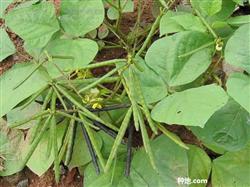How can mung bean be planted with high yield?

How can mung bean be planted with high yield? Please point out that mung bean has drought resistance, barren resistance, wide adaptability and short growth period, which is generally only 60-120 days; its suitable sowing period is very long, and it can be sown from early and middle April to early August. The main points of cultivation are as follows: first, soil preparation. Mung bean is a deep-rooted crop with hypertrophic cotyledons and strict requirements for soil preparation. Deep ploughing and fine raking should be made before sowing to achieve the consistency of upper and lower fruit and depth, otherwise seedling emergence will be affected. Second, fertilizing. Before sowing, 2500-3500 kg of farm manure and 10 kg of superphosphate were applied per mu; if there is no time to apply fertilizer, appropriate amount of nitrogen and phosphorus fertilizer can be applied in the early growth stage to enhance the nitrogen fixation of root nodules. Third, sow seeds. Before sowing, choose to spread the seeds thinly on the mat on a sunny day for 1 or 2 days to promote germination and emergence. The main sowing method is strip sowing, the row spacing is about 40 cm, the sowing rate is 1-1.5 kg per mu, and the sowing depth is 3-5 cm. If the soil moisture is poor after sowing, it can be suppressed once. Fourth, management. 1. Occasional and fixed seedlings. When the seedlings grow two leaves with one heart, get rid of the "pimple seedlings" and set the seedlings when they have four true leaves, leaving 10-12500 seedlings per mu. 2. Timely mid-tillage. When the two leaves are of one heart, a shallow ploughing is carried out to break the hardening, eradicate weeds and enhance the activity of root nodules. Ploughing the seedlings for the second time with four leaves, ploughing for the third time when the trees with five to six leaves are ploughed for the third time, and then ploughing again when you start to drag seedlings, completely get rid of the root protection weeds; 3, pay attention to watering and topdressing during the flower and pod period, and eliminate stagnant water in time in the rainy season, so that the soil is often in a loose and moist state to ensure the normal growth of plants; 4, control diseases and insect pests. In recent years, mung bean diseases and insect pests are mainly leaf spot, crickets, aphids and pod borer and so on. To control mung bean leaf spot, 1000 times of carbendazim gel suspension was sprayed at the initial stage of the disease, crickets could be used as poison bait made of 90% crystal trichlorfon, aphids were sprayed with 40% dimethoate 1000 times, and pod borer sprayed with 40% isopropyl phosphorus or 1000 times of 50% fenitrothion when adults were in full bloom. Click to get more mung bean planting technology click to get more grain and oil planting technology
- Prev

What should we pay attention to when planting mung beans?
What should we pay attention to when planting mung beans? Please point out that the cultivation of mung beans should be paid attention to: 1. Reform the farming system and increase the yield per unit area. Our city always sows mung beans after planting red pea, and soon after emergence, it is affected by high temperature and summer drought, which leads to insufficient vegetative growth, poor reproductive growth, relatively shortened growth period and reduced yield. Sum up the local.
- Next

How to grow mung beans with high yield?
How to grow mung beans with high yield? Please guide that the price of mung bean is relatively stable in recent years, coupled with lax soil requirements, simple planting, and the area is expanding year by year, which has become a good project for farmers to grow rich. Developed countries do not attach importance to the production of miscellaneous grains and beans. After China's entry into WTO, the export volume of mung beans has increased, and the price has risen steadily.
Related
- The first cup of black tea in spring, the flavor and history of tea gardens in Kenya, Africa
- The computer can not only choose potatoes, but also grow tea rice. AI will grow winter oolong tea champion.
- It is not only the inflated tea bitten by insects, but also engraved with the four seasons tea in Beipu.
- The Oriental Beauty Tea Festival in Zhuxian County takes the stage at the weekend to experience the plus-size feast of oil tea.
- & quot; Oriental Beauty Tea & Exploration of Emei in Hsinchu, the hometown of quot;
- The new variety of strawberry "Tainong 1" dessert is the first choice with mellow aroma. Crimson gorgeous
- History of Tea in Taiwan: from Wild Inner Mountain to Export Tea Garden
- Two types of Taiwan Oriental Beauty Black Tea won the British three-Star Award for Childhood Tea Xiang Zhang Jiaqi changed from pilot to champion tea maker.
- Banana species and varieties: the planting history of Taiwan Xianren banana and dwarf banana is long, is banana disease resistant?
- Coffee planting Technology: Qianjie Coffee from Seedling to harvesting

